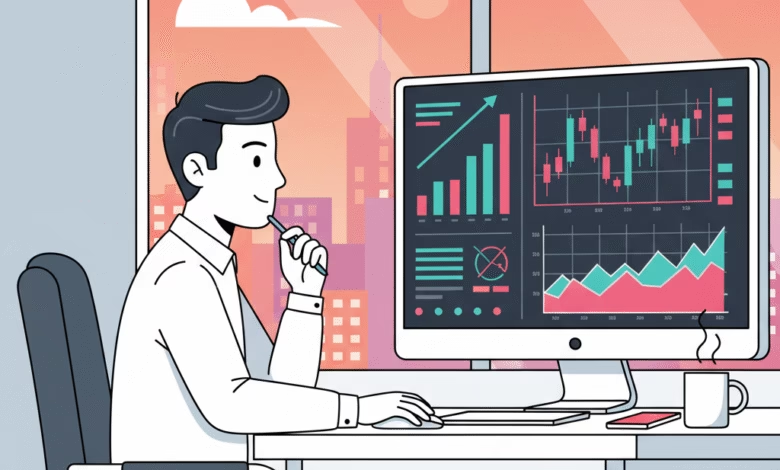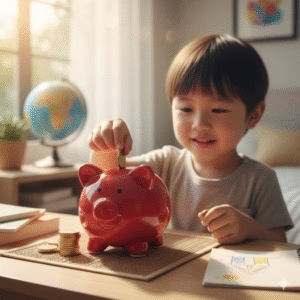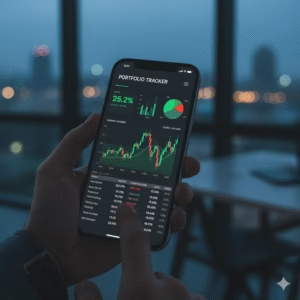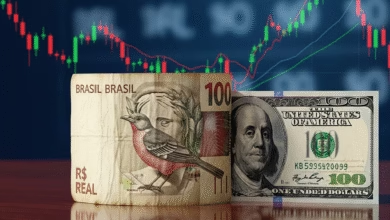How Stress and Anxiety Affect Financial Decisions
Understand how your mood can impact your finances

It’s 3:00 AM. You’re wide awake, staring at the ceiling. Your heart is pounding, and your mind is racing, stuck in a loop of financial “what-ifs.”
- What if the market crashes and my 401(k) is wiped out?
- What if I can’t make that credit card payment?
- What if I lose my job?
- Why did I spend so much money last month?
If this scene feels familiar, you are not alone. For millions of Americans, money is the number one source of chronic stress. But here’s the dangerous part: that very stress is what’s causing you to make worse financial decisions.
We all like to believe we are rational. We think we choose an investment based on data, apply for a loan based on the interest rate, and build a budget based on logic. But the moment stress and anxiety enter the picture, that rational brain—the one you trust—gets shut down.
It’s a vicious, self-perpetuating cycle: You’re stressed about money, so you make a bad financial decision, which in turn causes you even more stress.
This article isn’t about shaming you. It’s about pulling back the curtain on what’s happening inside your own mind. By understanding how stress hijacks your brain, you can finally build a system to protect your money from your own worst impulses.
Why Your Brain Makes Bad Decisions Under Pressure

To understand this, you need to know that you have two different “brains” competing for control. This is a concept, popularized by Nobel Prize-winning psychologist Daniel Kahneman, that divides your thinking into two systems.
- System 1 (The “Lizard Brain”): This is your ancient, fast, intuitive, and emotional brain (centered in the amygdala). It’s your “gut feeling.” It’s designed for one thing: survival. When a lion jumps out of the bushes, you don’t stop to analyze the situation; you react. This is your fight-or-flight response.
- System 2 (The “CEO Brain”): This is your modern, slow, analytical, and logical brain (the prefrontal cortex). It’s what you use to solve a math problem, plan for retirement, or compare the complex terms of two different mortgage loans.
Here’s the problem: When your brain detects a threat, System 1 stages a hostile takeover.
When you’re chronically stressed about debt or anxious about a volatile stock market, your brain doesn’t see a “balance sheet.” It sees a “lion.” It floods your body with stress hormones like cortisol and adrenaline, which effectively shut down your slow, logical “CEO brain.”
You are, quite literally, not thinking straight. Your financial decisions are no longer being made by your System 2 logic; they’re being made by your System 1 panic.
The 5 Most Common Financial “Symptoms” of Stress and Anxiety
When your “CEO brain” is offline, you start to exhibit predictable, irrational behaviors. These are the “symptoms” that your financial health is being compromised by stress.
1. Financial Paralysis (The “Ostrich Effect”)
This is one of the most common symptoms. The anxiety of knowing the truth is so overwhelming that you choose to not know.
- You let bills pile up on the kitchen counter, unopened.
- You avoid logging into your bank account or credit card portal for weeks at a time.
- You refuse to check your 401(k) balance during a market dip.
This “head in the sand” approach feels safer in the short term because it avoids the immediate pain of bad news. But it is financially catastrophic. It’s how you miss payments, rack up late fees, destroy your credit score, and let a small, manageable problem spiral into a five-alarm crisis.
2. Tunnel Vision and Panic Selling
Stress and anxiety narrow your focus. You lose all long-term perspective and can only see the immediate threat. This is the “fight-or-flight” response in action.
In investing, this is the #1 destroyer of wealth: panic selling.
When the stock market crashes (like in 2008 or 2020), your “lizard brain” screams, “THE LION IS HERE! GET TO SAFETY! SELL EVERYTHING!” You are so consumed by the pain of seeing your balance go down (a bias known as Loss Aversion) that you sell all your high-quality investments at the absolute bottom of the market.
You have just locked in your losses permanently. You were so focused on stopping the short-term pain that you sacrificed your entire long-term plan.
3. The “Retail Therapy” Trap (Impulsive Spending)
On the flip side of panic is the impulsive need for a “quick fix.” When you’re stressed, anxious, or depressed, your brain is desperate for a hit of dopamine, the “feel-good” chemical.
And what’s the fastest, most reliable way to get a dopamine hit in our society? Clicking “Buy Now.”
This is “retail therapy.” You had a terrible day at work, so you “deserve” that new $150 gadget or $200 pair of shoes. The purchase gives you a temporary high, a feeling of control, and a brief moment of relief from your anxiety.
But the high fades quickly, and the “shame hangover” sets in. You’re left with an item you didn’t need and, worse, a bigger credit card bill. This, in turn, increases your baseline level of financial stress, making you more likely to need another “fix” in the future. It’s a devastating feedback loop, all funded by high-APR credit cards.
4. Decision Fatigue and Poor Choices
Your “CEO brain” (System 2) is like a muscle. When you’re under chronic stress, that muscle is exhausted. This leads to decision fatigue.
You no longer have the mental energy or “bandwidth” to make good, complex choices. So, you start taking shortcuts.
- You sign up for a store credit card without reading the 29% interest rate.
- You take out a personal loan without shopping around for a better rate.
- You say “yes” to an expensive insurance add-on for a rental car just to get the transaction over with.
This is when you are most vulnerable. You’re not looking for the best option; you’re just looking for the easiest one that makes the stress go away.
5. The Scarcity Mindset: Being Too Cautious
While some people panic-sell, others panic-hoard.
If you grew up in a household with extreme financial instability, or if you’ve been “burned” by a past loss, anxiety can push you to the opposite extreme. You develop a scarcity mindset.
You become so terrified of losing a single dollar that you refuse to take any risk. You hoard all your money in a low-interest (or 0%) savings or checking account. You’re “safe” from a market crash, but you are guaranteeing a loss. You are letting inflation, the “silent thief,” eat away at your purchasing power every single year. Your fear of losing has prevented you from ever growing.
The Financial Stress Loop: When Debt Itself Causes More Anxiety

This is the most dangerous part of the entire cycle. Financial problems cause chronic stress. And that chronic stress causes worse financial problems.
Let’s trace the loop:
- The Problem: You have a $5,000 high-interest credit card bill (a source of chronic stress).
- The Anxiety: The stress of that debt makes you anxious and depressed. You’re suffering from decision fatigue.
- The Bad Decision: To get a “quick fix” for your low mood, you go on an impulsive “retail therapy” shopping spree, adding $500 more to the card.
- The Worse Problem: Your bill is now $5,500. Your stress and anxiety get worse.
- The Worse Decision: The anxiety is now unbearable. You just want it gone. Your “lizard brain” seeks the fastest, easiest solution. You see a commercial for a payday loan or a “debt consolidation” service with a sky-high interest rate. Your exhausted “CEO brain” doesn’t have the energy to fight. You sign up.
- The Crisis: You are now trapped. The predatory loan has multiplied your debt. Your stress is at a breaking point, and your ability to make a rational decision is completely gone.
This cycle is how people spiral into bankruptcy. It’s not a failure of character; it’s a predictable, psychological trap.
How to Build Your “Financial Firewall”: A Guide to Stress-Free Decision Making
You cannot eliminate stress from your life. You can, however, build a system that acts as a “firewall” between your emotional “lizard brain” and your money.
The goal is to make your most important financial decisions when you are calm, and automate that plan so your stressed-out future self can’t sabotage it.
1. Build Your “Anxiety Shield”: The Emergency Fund
This is Step Zero. The #1 tool for reducing financial anxiety is a fully-funded emergency fund.
An emergency fund (typically 3-6 months of your living expenses) is a cash buffer that sits in a high-yield savings account. It’s not an investment; it’s insurance. It’s what turns a “crisis” into a “manageable inconvenience.”
- Without an E-Fund: A $1,000 car repair is a disaster. You panic, put it on a credit card, and the stress cycle begins.
- With an E-Fund: A $1,000 car repair is… just an annoyance. You transfer the money, pay the bill, and move on. No stress. No debt.
2. Put Your Finances on Autopilot (The Ultimate Stress-Reducer)
If your “lizard brain” makes bad decisions, take the decision away from it. Automation is the single most powerful tool for this.
- Automate Your 401(k)/IRA: Have your retirement contribution pulled from your paycheck before you even see it. This is how you “pay yourself first.”
- Automate Your Savings: Set up an automatic transfer from your checking to your savings account for the day after you get paid.
- Automate Your Debt Payments: Set up automatic minimum (or full) payments for all your credit cards and loans. You will never be late again.
Automation builds wealth on autopilot. It removes your emotions, your impulses, and your laziness from the equation.
3. Create Your “Calm Brain” Contract (The Investment Policy Statement)
Your “CEO brain” is smart. Your “lizard brain” is dumb. So, have your CEO brain write a “contract” for your lizard brain to follow.
This is a simple, one-page document. Write it when you are calm and rational. Call it your “Investment Policy Statement” (IPS). It should answer:
- What is my financial goal? (e.g., “Retire by 65 with $1.5 million.”)
- What is my strategy? (e.g., “Invest 90% in a global index fund and 10% in bonds.”)
- What will I do in a market crash? (The answer should be: “Nothing. I will not sell. I will continue to buy as planned.”)
When the market does crash and your lizard brain is screaming “SELL!”, you are required to pull out this piece of paper and read it. It’s the voice of your past, rational self, saving you from your present, emotional self.
4. Use “Decision Friction” to Stop Impulse Spending
“Retail therapy” thrives on being fast and “frictionless.” The antidote is to add friction. Make it harder to spend.
- The 24-Hour Rule: For any non-essential purchase over $100, you must wait 24 hours. The dopamine hit will fade, and your “CEO brain” will come back online.
- Delete Saved Credit Cards: Go into your Amazon, DoorDash, and other favorite accounts and delete your saved payment info. Force yourself to get up, find your wallet, and manually type in the 16 digits. That tiny bit of “effort” is often enough to stop an impulse.
- Use Cash: For “danger” categories (like dining out or coffee), use an envelope with a set amount of cash for the week. When the cash is gone, it’s gone. It makes spending feel real again.
5. Know Your Triggers (The H.A.L.T. Method)
Your willpower is at its lowest when you are physically or emotionally compromised. Never, ever make a significant financial decision when you are:
- Hungry
- Angry
- Lonely
- Tired
If you’re in one of these states, your “lizard brain” is in charge. Your only job is to eat, sleep, or call a friend. Your financial decisions can wait until your “CEO brain” is back at the wheel.
Take Back Control by Building a Better System

Your financial stress is not a character flaw. You are not “bad with money.” You are a human being, hardwired with ancient survival instincts that are no longer well-suited to the modern financial world.
You cannot eliminate stress, and you cannot “out-think” your own anxiety in the heat of the moment.
The only way to win is to stop fighting. Stop relying on “willpower.” Instead, build a system—a system of automation, rules, and buffers—that makes your desired financial outcome the default.
This is how you break the cycle. This is how you move from a state of chronic financial anxiety to one of control, confidence, and, ultimately, peace.





